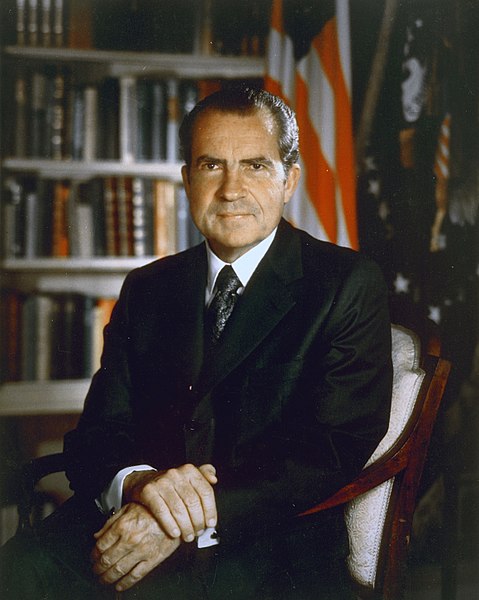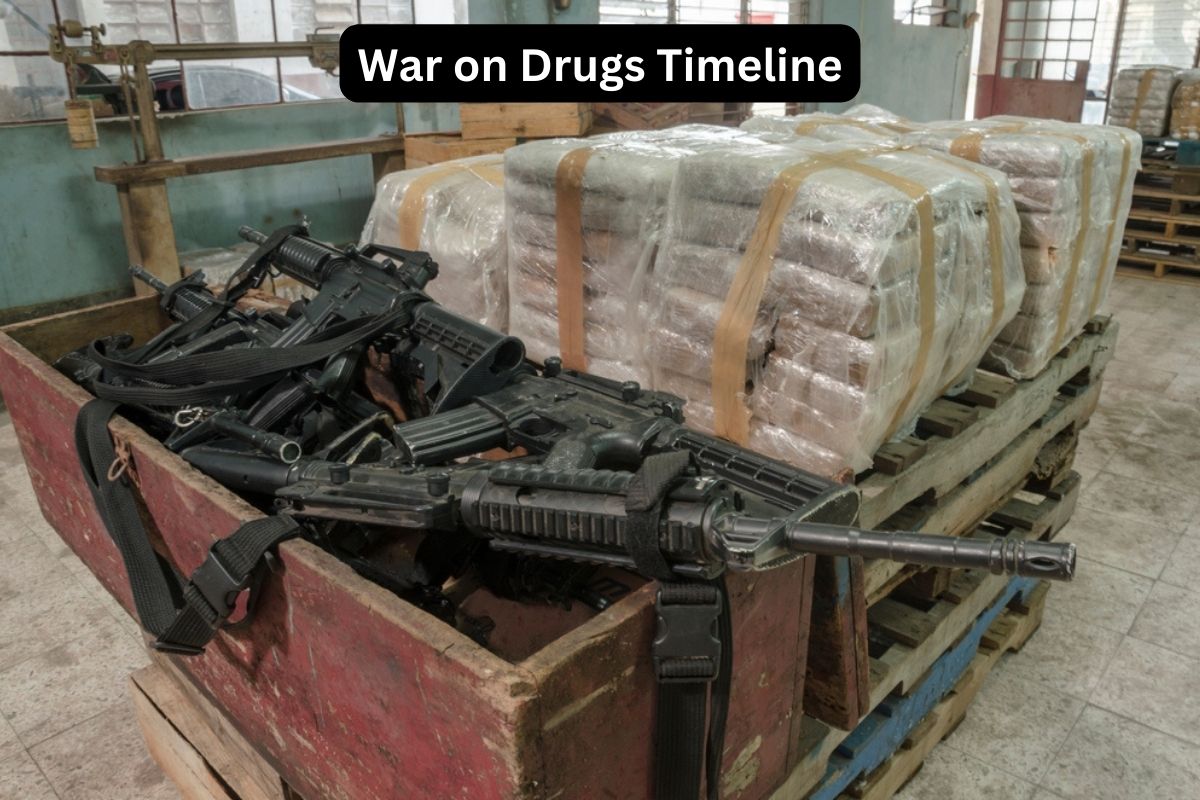The “War on Drugs” has been a defining feature of American domestic and foreign policy for decades, shaping legislation, law enforcement practices, and societal attitudes towards drug use and addiction.
Initiated by President Richard Nixon in the 1970s, the War on Drugs aimed to combat drug abuse and trafficking through aggressive enforcement measures and anti-drug campaigns.
However, over the years, this approach has faced criticism for its disproportionate impact on marginalized communities, harsh sentencing laws, and failure to address underlying issues of addiction and public health.
This article provides a chronological overview of key events in the War on Drugs, from its inception to recent legislative developments such as the MORE Act, which seeks to reform federal drug policy and address social equity in the cannabis industry.
| Year | Event |
|---|---|
| 1961 | The United Nations Single Convention on Narcotic Drugs is adopted. |
| 1969 | President Richard Nixon declares drug abuse as “public enemy number one” and officially launches the modern-day “War on Drugs.” |
| 1971 | President Nixon creates the Drug Enforcement Administration (DEA). |
| 1973 | The Rockefeller Drug Laws are enacted in New York, implementing strict penalties for drug offenses. |
| 1976 | President Gerald Ford signs the Medical Device Regulation Act, classifying drug paraphernalia as illegal. |
| 1980 | The Comprehensive Crime Control Act establishes mandatory minimum sentences for drug offenses. |
| 1984 | The Sentencing Reform Act establishes the U.S. Sentencing Commission, which creates federal sentencing guidelines, including harsh penalties for drug offenses. |
| 1986 | The Anti-Drug Abuse Act imposes mandatory minimum sentences for drug offenses, including the notorious 100:1 sentencing disparity between crack and powder cocaine. |
| 1989 | President George H.W. Bush declares a new phase of the War on Drugs, calling for increased funding and enforcement efforts. |
| 1994 | President Bill Clinton signs the Violent Crime Control and Law Enforcement Act, further expanding mandatory minimum sentences for drug offenses and increasing funding for law enforcement. |
| 1997 | The Office of National Drug Control Policy launches the National Youth Anti-Drug Media Campaign, known for its “Just Say No” slogan. |
| 1998 | California passes Proposition 36, offering non-violent drug offenders treatment instead of incarceration. |
| 2001 | President George W. Bush creates the High-Intensity Drug Trafficking Areas (HIDTA) program, aiming to coordinate federal, state, and local efforts to combat drug trafficking. |
| 2003 | Mexico’s President Felipe Calderón launches a military-led offensive against drug cartels, sparking a surge in violence known as the Mexican Drug War. |
| 2009 | President Barack Obama’s administration announces a shift in focus towards drug prevention and treatment rather than solely law enforcement. |
| 2012 | Colorado and Washington become the first U.S. states to legalize recreational marijuana. |
| 2016 | President Obama commutes the sentences of hundreds of non-violent drug offenders, particularly those sentenced under harsh crack cocaine laws. |
| 2018 | President Donald Trump signs the First Step Act, aiming to reform federal sentencing laws and reduce recidivism. |
| 2020 | Oregon becomes the first U.S. state to decriminalize possession of small amounts of all drugs, instead emphasizing addiction treatment. |
| 2021 | The MORE Act (Marijuana Opportunity Reinvestment and Expungement Act) passes the U.S. House of Representatives, seeking to federally decriminalize marijuana and address social equity in the cannabis industry. |
Timeline of the War on Drugs
1960s
1961: The United Nations Single Convention on Narcotic Drugs is adopted. This international treaty aims to combat drug abuse and illicit trafficking globally by regulating the production, distribution, and possession of certain narcotic drugs.
Also Read: Facts About the War on Drugs
1969: President Richard Nixon declares drug abuse as “public enemy number one” and officially launches the modern-day “War on Drugs.” This declaration marks the beginning of a concerted effort by the United States government to address drug-related issues through increased law enforcement, stricter penalties, and anti-drug education campaigns.

1970s
1971: President Nixon creates the Drug Enforcement Administration (DEA), consolidating various federal drug enforcement agencies under one umbrella organization. The DEA is tasked with enforcing the controlled substances laws and regulations of the United States.
1973: The Rockefeller Drug Laws are enacted in New York. These laws, named after then-Governor Nelson Rockefeller, establish some of the harshest penalties for drug offenses in the United States, including mandatory minimum sentences for possession and sale of narcotics.
Also Read: Drug Trafficking Facts
1976: President Gerald Ford signs the Medical Device Regulation Act, which expands the definition of drug paraphernalia and imposes penalties for its manufacture, distribution, and sale. This legislation aims to curtail the use of drug paraphernalia in facilitating drug abuse.
1980s
1980: The Comprehensive Crime Control Act is signed into law, establishing mandatory minimum sentences for drug offenses and expanding the scope of federal drug enforcement efforts. This legislation marks a significant escalation in the War on Drugs, with an emphasis on punitive measures to deter drug-related crimes.
1984: The Sentencing Reform Act is enacted, establishing the U.S. Sentencing Commission and implementing federal sentencing guidelines. These guidelines aim to ensure consistency and fairness in sentencing, including for drug offenses, but also lead to harsh penalties for certain drug crimes.

1986: The Anti-Drug Abuse Act is passed, imposing stricter penalties for drug offenses and introducing the notorious 100:1 sentencing disparity between crack cocaine and powder cocaine. This legislation exacerbates racial disparities in the criminal justice system, as crack cocaine offenses disproportionately affect Black communities.
1989: President George H.W. Bush declares a new phase of the War on Drugs, emphasizing international cooperation, increased funding for drug enforcement agencies, and a focus on reducing drug demand through prevention and treatment programs. This marks a continuation of the tough-on-crime approach to drug policy.
1990s
1994: President Bill Clinton signs the Violent Crime Control and Law Enforcement Act into law. This comprehensive crime bill includes provisions that further escalate the War on Drugs, such as the “three strikes” rule, which imposes mandatory life sentences for certain repeat offenders, including those convicted of drug offenses. The bill also allocates significant funding for law enforcement efforts and expands the use of asset forfeiture in drug-related cases.
1997: The Office of National Drug Control Policy launches the National Youth Anti-Drug Media Campaign. This campaign, known for its “Just Say No” slogan, utilizes media outreach and educational programs to discourage youth from using drugs and promote a drug-free lifestyle. While initially well-funded and widely publicized, the effectiveness of the campaign later comes under scrutiny.
1998: California voters pass Proposition 36, also known as the Substance Abuse and Crime Prevention Act. This landmark initiative allows eligible non-violent drug offenders to receive substance abuse treatment instead of incarceration. Proposition 36 represents a shift towards a more rehabilitative approach to drug policy, focusing on treatment and diversion rather than solely punitive measures.

2000s
2001: President George W. Bush establishes the High-Intensity Drug Trafficking Areas (HIDTA) program through an executive order. This program aims to address drug trafficking and related criminal activities in designated areas of the United States by coordinating federal, state, and local law enforcement efforts and providing additional resources for drug control activities.
2003: Mexico’s President Felipe Calderón launches a military-led offensive against drug cartels, escalating the conflict known as the Mexican Drug War. Calderón’s crackdown on drug trafficking organizations leads to increased violence and instability in Mexico, with tens of thousands of deaths and widespread human rights abuses documented throughout the conflict.
2009: President Barack Obama’s administration announces a shift in drug policy priorities, emphasizing a greater focus on drug prevention, treatment, and harm reduction strategies. This approach represents a departure from the predominantly punitive tactics of previous administrations, acknowledging the need for a more balanced and evidence-based approach to addressing drug-related issues.

2010s
2012: Colorado and Washington become the first U.S. states to legalize recreational marijuana for adults aged 21 and older through voter-approved ballot initiatives. These historic measures mark a significant shift in drug policy, with the states regulating and taxing cannabis sales for recreational use.
2016: President Obama grants clemency to hundreds of non-violent drug offenders, particularly those serving lengthy sentences for crack cocaine offenses. The move is part of broader criminal justice reform efforts aimed at addressing disparities in sentencing and reducing the prison population.
2018: President Donald Trump signs the First Step Act into law, a bipartisan criminal justice reform bill aimed at reducing recidivism and reforming federal sentencing laws. Among its provisions, the act expands rehabilitative programs for inmates, promotes alternatives to incarceration for low-risk offenders, and reduces mandatory minimum sentences for certain drug offenses.
2020s
2020: Oregon becomes the first U.S. state to decriminalize the possession of small amounts of all drugs, including heroin, cocaine, and methamphetamine. Instead of facing criminal penalties, individuals found in possession of small quantities of drugs are referred to addiction treatment services. The measure aims to prioritize public health and harm reduction over punitive measures.
2021: The U.S. House of Representatives passes the MORE Act (Marijuana Opportunity Reinvestment and Expungement Act), which seeks to federally decriminalize marijuana and address social equity in the cannabis industry. The bill removes cannabis from the list of controlled substances, expunges prior convictions for marijuana-related offenses, and reinvests in communities disproportionately impacted by the war on drugs.
